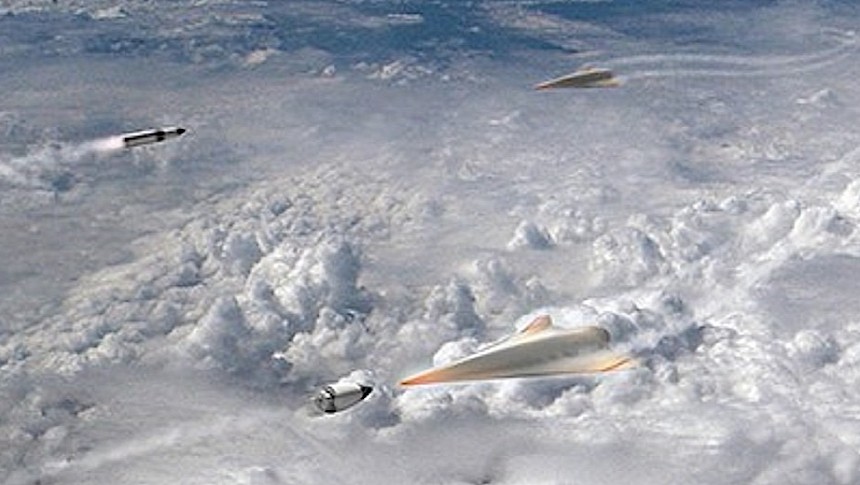There is no doubt that the future of warfare will be centered on two new types of weapons: the highly versatile drones, and the nearly unstoppable hypersonic missile. Both of them are used in the world's largest current conflict, the one in Ukraine, with devastating effects, and their use has woken up pretty much all of the world's militaries.
The U.S. does have perhaps the world's largest and most diverse drone fleet, but it doesn't have nearly enough hypersonic weapons. That's rockets and missiles that can fly at speeds of over Mach 5 (3,800 mph/6,100 kph), well beyond the capabilities of any of today's interceptors. The nation is working on solving this problem, though.
Some rival nations, Russia included, do claim to have operational hypersonic missiles, and that means the U.S. will need interceptors capable of shooting them down if need be as well. One research direction in this respect is called Glide Breaker.
The project was announced all the way back in 2018 as one meant to deliver an interceptor meant to stop a hypersonic weapon during its glide phase. That's the moment when the weapon separates from its booster after the peak of trajectory in the planet's upper atmosphere and begins a gravity-assisted, flatter trajectory down to the target.
In the spring of last year DARPA, the brains behind the Glide Breaker idea, announced it was looking to start wind tunnel and flight testing of such a system, looking for proposals and ideas from industry partners.
It's been more than a year since that announcement, and we're only now getting an update on the project, this time from aerospace giant Boeing.
The company announced last week it is in the process of developing and testing "technologies for a hypersonic interceptor prototype for DARPA's Glide Breaker program" as part of a four-year effort.
There seems to be no prototype to work with yet, but Boeing says it will "perform computational fluid dynamics analysis, wind tunnel testing and evaluation" of the aerodynamic jet interaction effects on the interceptor during flight tests.
The main goal of the testing is to determine how to best use hypersonic airflow and jet thrusters to guide the interceptor at hypersonic speeds toward the target, but also to understand how that affects the system itself at such speeds and altitudes.
Given the secretive nature of the work no additional details into the Glide Breaker interceptor were provided, nor do we have an exact timeline as to when some piece of hardware to be test flown will be ready. The project is still in the theoretical stage, so no actual prototype is in the works yet.
Neither of the parties involved said anything about when the Glide Breaker should be ready to serve, if ever.
Some rival nations, Russia included, do claim to have operational hypersonic missiles, and that means the U.S. will need interceptors capable of shooting them down if need be as well. One research direction in this respect is called Glide Breaker.
The project was announced all the way back in 2018 as one meant to deliver an interceptor meant to stop a hypersonic weapon during its glide phase. That's the moment when the weapon separates from its booster after the peak of trajectory in the planet's upper atmosphere and begins a gravity-assisted, flatter trajectory down to the target.
In the spring of last year DARPA, the brains behind the Glide Breaker idea, announced it was looking to start wind tunnel and flight testing of such a system, looking for proposals and ideas from industry partners.
It's been more than a year since that announcement, and we're only now getting an update on the project, this time from aerospace giant Boeing.
The company announced last week it is in the process of developing and testing "technologies for a hypersonic interceptor prototype for DARPA's Glide Breaker program" as part of a four-year effort.
There seems to be no prototype to work with yet, but Boeing says it will "perform computational fluid dynamics analysis, wind tunnel testing and evaluation" of the aerodynamic jet interaction effects on the interceptor during flight tests.
The main goal of the testing is to determine how to best use hypersonic airflow and jet thrusters to guide the interceptor at hypersonic speeds toward the target, but also to understand how that affects the system itself at such speeds and altitudes.
Given the secretive nature of the work no additional details into the Glide Breaker interceptor were provided, nor do we have an exact timeline as to when some piece of hardware to be test flown will be ready. The project is still in the theoretical stage, so no actual prototype is in the works yet.
Neither of the parties involved said anything about when the Glide Breaker should be ready to serve, if ever.





